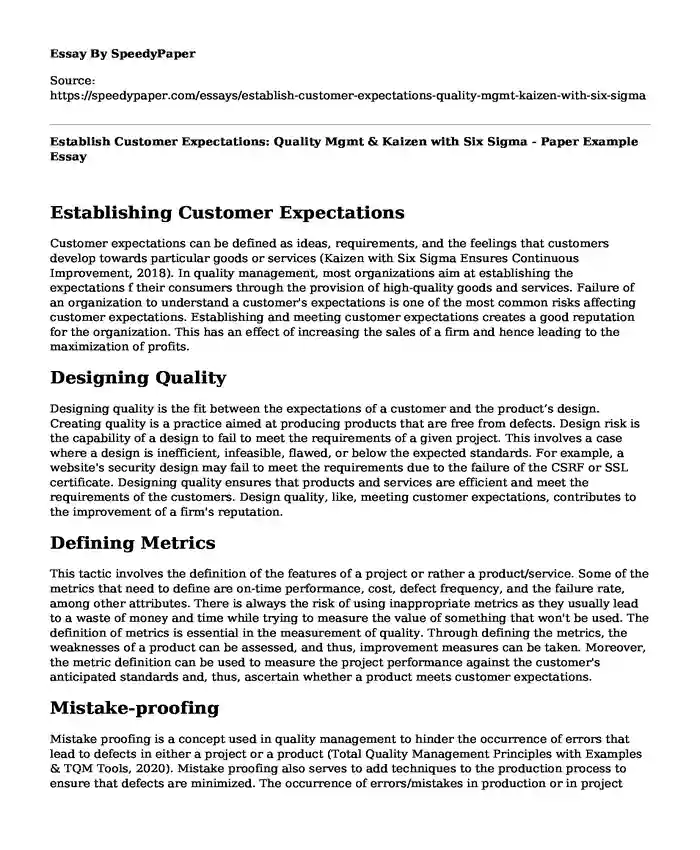
| Type of paper: | Essay |
| Categories: | Management Business Analysis |
| Pages: | 3 |
| Wordcount: | 753 words |
Establishing Customer Expectations
Customer expectations can be defined as ideas, requirements, and the feelings that customers develop towards particular goods or services (Kaizen with Six Sigma Ensures Continuous Improvement, 2018). In quality management, most organizations aim at establishing the expectations f their consumers through the provision of high-quality goods and services. Failure of an organization to understand a customer's expectations is one of the most common risks affecting customer expectations. Establishing and meeting customer expectations creates a good reputation for the organization. This has an effect of increasing the sales of a firm and hence leading to the maximization of profits.
Designing Quality
Designing quality is the fit between the expectations of a customer and the product’s design. Creating quality is a practice aimed at producing products that are free from defects. Design risk is the capability of a design to fail to meet the requirements of a given project. This involves a case where a design is inefficient, infeasible, flawed, or below the expected standards. For example, a website's security design may fail to meet the requirements due to the failure of the CSRF or SSL certificate. Designing quality ensures that products and services are efficient and meet the requirements of the customers. Design quality, like, meeting customer expectations, contributes to the improvement of a firm's reputation.
Defining Metrics
This tactic involves the definition of the features of a project or rather a product/service. Some of the metrics that need to define are on-time performance, cost, defect frequency, and the failure rate, among other attributes. There is always the risk of using inappropriate metrics as they usually lead to a waste of money and time while trying to measure the value of something that won't be used. The definition of metrics is essential in the measurement of quality. Through defining the metrics, the weaknesses of a product can be assessed, and thus, improvement measures can be taken. Moreover, the metric definition can be used to measure the project performance against the customer's anticipated standards and, thus, ascertain whether a product meets customer expectations.Mistake-proofing
Mistake proofing is a concept used in quality management to hinder the occurrence of errors that lead to defects in either a project or a product (Total Quality Management Principles with Examples & TQM Tools, 2020). Mistake proofing also serves to add techniques to the production process to ensure that defects are minimized. The occurrence of errors/mistakes in production or in project management is inevitable. Mistakes can occur at any step of management, and thus, appropriate measures to ensure that mistakes are minimized can serve to improve the quality of production. The reduction of errors in the production process leads to the achievement of high levels of quality of the products/projects. The occurrence of defects and mistakes leads to organizational expenditure on factors that are just a wastage of time and resources.
Kaizen
The word Kaizen is derived from a Japanese term that means 'change for the better’ or rather “continuous improvement (Kaizen with Six Sigma Ensures Continuous Improvement, 2018).” One of the significant risks of adopting Kaizen is that it leads to the distortion of the whole management system, which may cause difficulties in training the staff to adapt to new changes. Kaizen may also be a costly style, and thus its adoption may consume the significant value of the organizational resources. Kaizen's value is that it promotes teamwork, personal discipline, and the improvement of staff morale. Kaizen also attracts suggestions for improvement.
Six Sigma
This method is used to enable businesses/ organizations to improve existing processes, services, and products through identification and the elimination of defects (Grimes, 2019). The use of Six Sigma can be costly, especially for small businesses (Kaizen with Six Sigma Ensures Continuous Improvement, 2018). This may be caused by the high cost of training the Six Sigma principles. The value of Six Sigma is that it helps eliminate defects that may occur in the production process. Through the use of the six sigma methodology, employees can identify areas where errors occur and thus take adequate measures to ensure that such defects are eliminated.
References
Quality Management Tools – including TQM, Six Sigma, Cost of Quality and EFQM. (2013, June 11). https://www.cgma.org/resources/tools/essential-tools/quality-management-tools.html
Quality Management – BusinessBalls.com. https://www.businessballs.com/performance-management/quality-management-history-gurus-tqm-process-improvement-etc/
Six Sigma Definition - What is Lean Six Sigma? | ASQ. https://asq.org/quality-resources/six-sigma
Total Quality Management Principles with Examples & TQM Tools. ReQtest. (2020, June 3). https://reqtest.com/testing-blog/total-quality-management/
Cite this page
Establish Customer Expectations: Quality Mgmt & Kaizen with Six Sigma - Paper Example. (2023, Nov 30). Retrieved from https://speedypaper.com/essays/establish-customer-expectations-quality-mgmt-kaizen-with-six-sigma
Request Removal
If you are the original author of this essay and no longer wish to have it published on the SpeedyPaper website, please click below to request its removal:
- Essay Example on Footwear Industry Analysis
- A Mock Causal-Comparative Study. Free Paper Sample.
- Free Essay for Everyone on Streaming and SoundCloud
- Free Essay- Process of Public Offering Occurrence
- Free Essay Example: Types of Business Organization
- Investment Project to Start After Completion of Schooling. Free Essay
- Free Paper Sample on German Warplane Technology During World Wars
Popular categories




